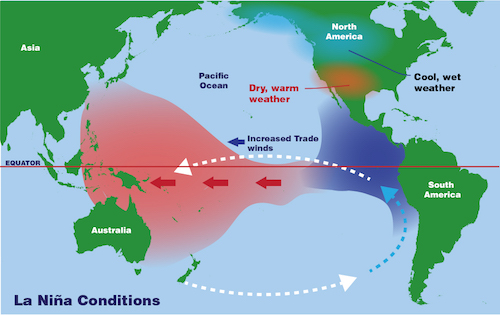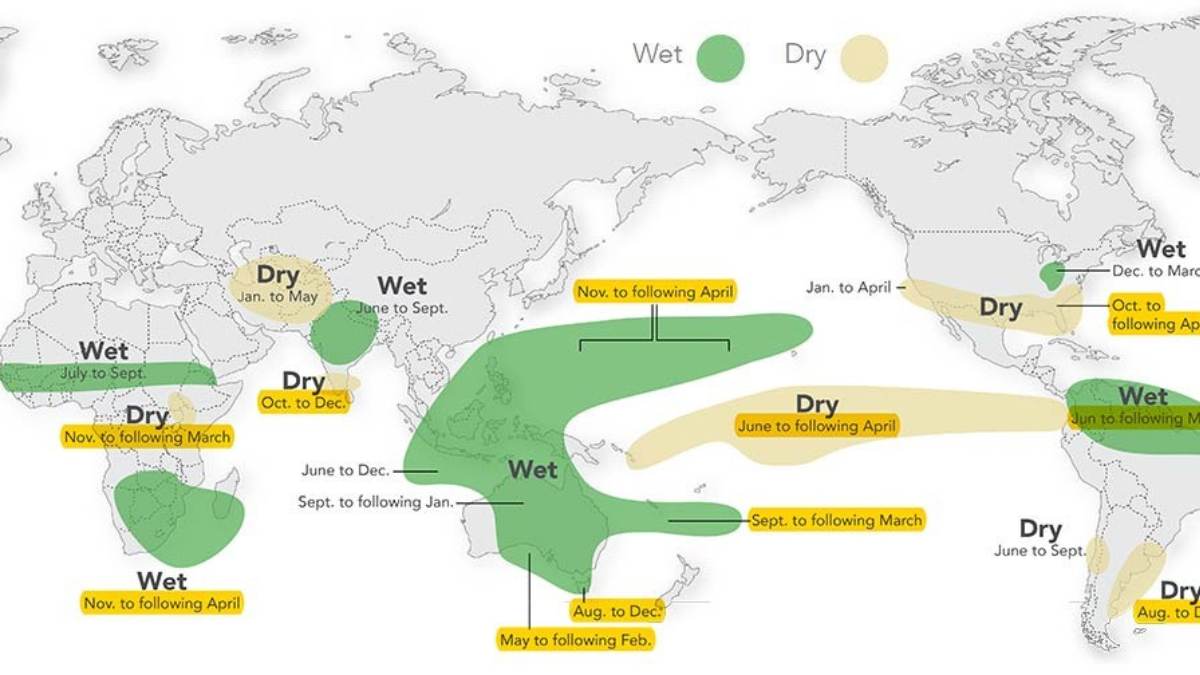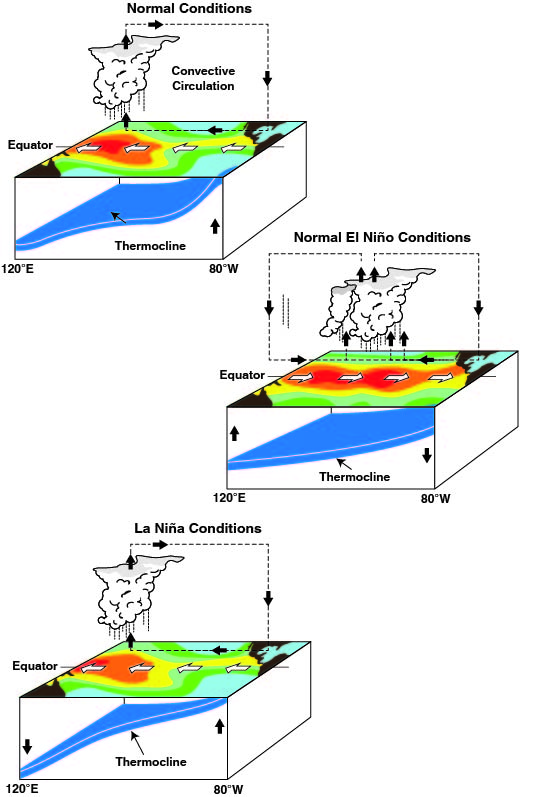La Niña 2025: What it Means & Impacts for India?
The climate is a complex and interconnected system, and understanding its various cycles and patterns is crucial for preparing for the future. One of the most significant climate drivers globally is the El Niño-Southern Oscillation (ENSO), which oscillates between two phases: El Niño and La Niña. While El Niño, characterised by warmer-than-average sea surface temperatures in the central and eastern equatorial Pacific Ocean, often grabs headlines for its association with droughts and heatwaves in some regions, La Niña, its cooler counterpart, brings a different set of challenges and opportunities. As we look towards 2025, the potential emergence of La Niña is a topic of considerable interest and concern, particularly for a nation as reliant on monsoon rains as India. This comprehensive guide delves into what La Niña 2025 could mean for India, exploring its potential impacts on the monsoon, agriculture, economy, and overall environment.
Understanding La Niña: The Basics
La Niña, Spanish for 'the girl,' is characterised by freezing sea surface temperatures in the central and eastern equatorial Pacific Ocean. These cooler waters influence atmospheric circulation patterns globally, leading to a cascade of effects on weather systems worldwide. The phenomenon is the opposite of El Niño, and the two alternate irregularly, typically every two to seven years. However, the period between El Niño and La Niña can vary considerably. Scientists monitor various indicators, including sea surface temperatures, wind patterns, and atmospheric pressure, to predict the onset, intensity, and duration of La Niña events.
The Science Behind La Niña
The Walker Circulation, an air circulation pattern in the tropical Pacific, plays a central role in the ENSO cycle. During normal conditions, trade winds blow from east to west across the Pacific, pushing warm surface water towards Asia and Australia. This causes upwelling of colder, nutrient-rich water along the coast of South America. In a La Niña event, these trade winds strengthen, leading to even greater upwelling and cooler sea surface temperatures in the eastern Pacific. This intensification of the Walker Circulation has far-reaching consequences, affecting rainfall patterns, jet streams, and atmospheric pressure systems across the globe. The strengthened trade winds also accumulate warm water in the western Pacific, often leading to increased rainfall in regions like Indonesia and Australia.
Key Indicators for La Niña
Several key indicators are used to monitor and predict La Niña events. These include:
- Sea Surface Temperatures (SSTs): Monitoring SST anomalies (deviations from the average) in the Niño 3.4 region of the equatorial Pacific is crucial. A sustained cooling of 0.5°C or more below the average in this region for several consecutive months typically indicates La Niña conditions.
- Oceanic Niño Index (ONI): The ONI is a three-month running mean of SST anomalies in the Niño 3.4 region and is a primary indicator used by NOAA (National Oceanic and Atmospheric Administration) to define El Niño and La Niña events.
- Southern Oscillation Index (SOI): The SOI measures the difference in air pressure between Tahiti and Darwin, Australia. A positive SOI (higher pressure difference) is typically associated with La Niña, indicating stronger trade winds.
- Wind Patterns: Strengthening of the easterly trade winds across the Pacific is a key indicator of La Niña.
- Atmospheric Circulation Patterns: Changes in atmospheric circulation patterns, such as the position of the jet stream, can also provide clues about the development of La Niña.
La Niña and the Indian Monsoon: A Complex Relationship
The Indian monsoon, a vital weather system that delivers the majority of India's annual rainfall, is significantly influenced by ENSO. While El Niño is often associated with weakened monsoons and droughts in India, La Niña generally, but not always, enhances the monsoon, leading to increased rainfall. However, the relationship is not a simple one-to-one correlation, and other factors, such as the Indian Ocean Dipole (IOD) and the Madden-Julian Oscillation (MJO), also play a crucial role in determining the monsoon's behaviour.
The Historical Connection
Historically, several strong La Niña events have coincided with above-normal monsoon rainfall in India. For instance, the La Niña events of 1998-2001 and 2010-2012 were associated with periods of heavy rainfall and, in some cases, devastating floods. However, it’s crucial to remember that not all La Niña years result in exceptionally strong monsoons. The interplay of various climate factors determines the final outcome.
Why La Niña Doesn't Guarantee a Strong Monsoon
While La Niña generally favours a stronger monsoon, other factors can modulate its effects. These include:
- Indian Ocean Dipole (IOD): The IOD is a temperature difference between the eastern and western Indian Ocean. A positive IOD, characterised by warmer waters in the western Indian Ocean and cooler waters in the east, typically enhances the monsoon. A negative IOD can counteract the positive influence of La Niña.
- Madden-Julian Oscillation (MJO): The MJO is a tropical disturbance that travels eastward around the globe. Its phase can influence the intensity and distribution of monsoon rainfall.
- Eurasian Snow Cover: Extensive snow cover over Eurasia in the winter months can weaken the subsequent monsoon.
- Regional Weather Systems: Local weather systems and atmospheric conditions can also influence rainfall patterns during the monsoon season.
Potential Impacts of La Niña 2025 on India
If La Niña develops as predicted in 2025, India could face a range of potential impacts, both positive and negative. While increased rainfall can benefit agriculture and replenish water resources, it can also lead to devastating floods, infrastructure damage, and the displacement of communities. A nuanced understanding of these potential impacts is essential for effective preparedness and mitigation.
Impact on Agriculture
Agriculture is the backbone of the Indian economy, employing a significant portion of the population and contributing substantially to the GDP. The monsoon rains are critical for irrigating crops, particularly rice, which is a staple food for millions of Indians. La Niña, with its potential to enhance monsoon rainfall, can have a significant impact on agricultural production.
- Increased Crop Yields: Above-normal rainfall can lead to increased crop yields for rice, wheat, pulses, and other rain-fed crops. This can boost agricultural income and contribute to food security.
- Improved Irrigation: Increased rainfall can replenish reservoirs and groundwater levels, improving irrigation for agriculture in regions that rely on these sources.
- Risk of Flooding: Excessive rainfall can lead to devastating floods, inundating agricultural fields and destroying crops. This can result in significant economic losses for farmers.
- Waterlogging: Prolonged periods of heavy rainfall can cause waterlogging in agricultural fields, damaging crops and hindering their growth.
- Impact on Crop Quality: Excessive moisture can also affect the quality of certain crops, making them susceptible to diseases and pests.
Impact on the Economy
The Indian economy is closely tied to the performance of the agricultural sector. A strong monsoon can boost agricultural production, leading to increased rural income, higher consumer demand, and overall economic growth. Conversely, a weak monsoon can have a ripple effect, impacting various sectors of the economy.
- Boost to Rural Economy: Increased agricultural production can lead to higher rural income, stimulating demand for goods and services in rural areas.
- Reduced Inflation: A good monsoon can help keep food prices in check, reducing inflationary pressures on the economy.
- Impact on Industrial Sector: The industrial sector, particularly industries reliant on agricultural raw materials, can benefit from increased agricultural production.
- Infrastructure Damage: Excessive rainfall and floods can damage infrastructure, such as roads, bridges, and power grids, disrupting economic activity.
- Increased Disaster Management Costs: Dealing with floods and other natural disasters can strain government resources, increasing disaster management costs.
Impact on Water Resources
Water resources are crucial for agriculture, industry, and domestic use. The monsoon rains replenish rivers, reservoirs, and groundwater levels, ensuring water availability throughout the year. La Niña can significantly impact water resources in India.
- Increased Water Availability: Above-normal rainfall can replenish reservoirs and groundwater levels, improving water availability for various uses.
- Improved Irrigation: Increased water availability can enhance irrigation for agriculture, boosting crop yields.
- Reduced Water Scarcity: La Niña can help alleviate water scarcity in regions that are prone to droughts.
- Risk of Floods: Excessive rainfall can lead to devastating floods, causing widespread damage and displacement.
- Water Quality Issues: Floods can contaminate water sources, leading to water quality issues and health risks.
Impact on Human Health
Extreme weather events associated with La Niña, such as floods and heavy rainfall, can have significant impacts on human health.
- Increased Risk of Waterborne Diseases: Floods can contaminate water sources, leading to outbreaks of waterborne diseases such as cholera, typhoid, and hepatitis A.
- Increased Risk of Vector-borne Diseases: Stagnant water after floods can create breeding grounds for mosquitoes, increasing the risk of vector-borne diseases such as malaria, dengue fever, and chikungunya.
- Malnutrition: Floods can disrupt food supplies, leading to malnutrition, particularly among vulnerable populations.
- Injuries and Displacement: Floods can cause injuries and displacement, putting a strain on healthcare systems.
- Mental Health Issues: Experiencing floods and other natural disasters can lead to mental health issues such as anxiety, depression, and post-traumatic stress disorder (PTSD).
Impact on the Environment
La Niña-related weather patterns can also have significant environmental consequences.
- Soil Erosion: Heavy rainfall can lead to soil erosion, degrading agricultural land and affecting its productivity.
- Deforestation: Floods can cause deforestation, as trees are uprooted and swept away by floodwaters.
- Loss of Biodiversity: Floods can destroy habitats, leading to the loss of biodiversity.
- Water Pollution: Floods can carry pollutants into water bodies, degrading water quality and harming aquatic life.
- Landslides: Heavy rainfall can trigger landslides, causing damage to infrastructure and loss of life, particularly in hilly regions.
Preparing for La Niña 2025: Mitigation and Adaptation Strategies
Given the potential impacts of La Niña 2025 on India, it is crucial to implement effective mitigation and adaptation strategies. This requires a multi-faceted approach involving government agencies, local communities, and individuals.
Government Initiatives
Government agencies play a crucial role in preparing for and responding to La Niña events. Some key initiatives include:
- Early Warning Systems: Investing in and improving early warning systems for floods and other extreme weather events can help communities prepare and evacuate on time.
- Disaster Management Plans: Developing and implementing comprehensive disaster management plans at the national, state, and local levels is essential for coordinating response efforts.
- Infrastructure Development: Investing in infrastructure development, such as flood control measures, dams, and drainage systems, can help mitigate the impact of floods.
- Agricultural Support: Providing support to farmers through crop insurance schemes, subsidised inputs, and access to credit can help them cope with the impacts of La Niña.
- Public Awareness Campaigns: Conducting public awareness campaigns to educate communities about the risks of La Niña and how to prepare for them is crucial.
Community-Based Adaptation
Community-based adaptation strategies are essential for building resilience to La Niña events at the local level.
- Flood-Resistant Housing: Promoting the construction of flood-resistant housing in flood-prone areas can help minimise damage and displacement.
- Water Management Practices: Implementing sustainable water management practices, such as rainwater harvesting and water conservation, can help improve water availability.
- Diversified Livelihoods: Promoting diversified livelihoods, such as non-farm activities, can help reduce dependence on agriculture and build resilience to climate shocks.
- Community-Based Disaster Preparedness: Training communities in disaster preparedness and response can help them cope with floods and other extreme weather events.
- Ecosystem-Based Adaptation: Protecting and restoring ecosystems, such as mangroves and wetlands, can help buffer communities from the impacts of floods.
Individual Actions
Individuals can also play a role in preparing for La Niña events.
- Stay Informed: Stay informed about weather forecasts and warnings from reliable sources.
- Prepare an Emergency Kit: Prepare an emergency kit with essential supplies such as food, water, medicine, and a first-aid kit.
- Secure Your Home: Secure your home by clearing drains, reinforcing weak structures, and elevating valuables.
- Evacuation Plan: Develop an evacuation plan and practice it with your family.
- Community Participation: Participate in community-based disaster preparedness activities.
Long-Term Implications of Climate Change
It's important to remember that La Niña is just one piece of the larger climate change puzzle. The increasing frequency and intensity of extreme weather events are a direct consequence of global warming, driven by human activities. Addressing climate change through mitigation and adaptation measures is crucial for ensuring a sustainable future.
Mitigation Strategies
Mitigation strategies focus on reducing greenhouse gas emissions, the primary driver of climate change. Some key mitigation strategies include:
- Transition to Renewable Energy: Shifting from fossil fuels to renewable energy sources such as solar, wind, and hydro power can significantly reduce greenhouse gas emissions.
- Energy Efficiency: Improving energy efficiency in buildings, transportation, and industry can reduce energy consumption and emissions.
- Sustainable Transportation: Promoting sustainable transportation options such as public transport, cycling, and walking can reduce emissions from the transportation sector.
- Afforestation and Reforestation: Planting trees can absorb carbon dioxide from the atmosphere, helping to mitigate climate change.
- Carbon Capture and Storage: Developing and deploying carbon capture and storage technologies can capture carbon dioxide emissions from industrial sources and store them underground.
Adaptation Strategies
Adaptation strategies focus on adjusting to the impacts of climate change that are already happening and are projected to worsen in the future. Some key adaptation strategies include:
- Climate-Resilient Infrastructure: Building infrastructure that is resilient to extreme weather events, such as floods and droughts, is crucial for protecting communities and economies.
- Water Resource Management: Implementing sustainable water resource management practices, such as water conservation and drought-resistant crops, can help ensure water security in a changing climate.
- Climate-Smart Agriculture: Promoting climate-smart agricultural practices, such as drought-resistant crops and water-efficient irrigation, can help farmers adapt to changing weather patterns.
- Disaster Risk Reduction: Strengthening disaster risk reduction measures, such as early warning systems and evacuation plans, can help communities prepare for and respond to extreme weather events.
- Public Health Preparedness: Strengthening public health systems to prepare for and respond to the health impacts of climate change, such as heat waves and vector-borne diseases, is crucial.
Conclusion: Navigating the Challenges and Opportunities of La Niña 2025
The potential arrival of La Niña in 2025 presents both challenges and opportunities for India. While increased rainfall can benefit agriculture and replenish water resources, it also carries the risk of devastating floods and other extreme weather events. By understanding the science behind La Niña, implementing effective mitigation and adaptation strategies, and addressing the long-term implications of climate change, India can navigate these challenges and build a more resilient and sustainable future. Preparation, proactive measures, and a collaborative approach are key to minimising potential damages and maximising the benefits a La Niña year can bring. Continuous monitoring of the relevant climate indicators and updating strategies based on the latest scientific understanding is also crucial for effective management of the risks and opportunities associated with La Niña 2025 and beyond.
Disclaimer: This article provides general information about La Niña and its potential impacts on India. It is not a substitute for expert advice. Please consult with qualified professionals for specific guidance on weather forecasting, disaster management, and agricultural planning.







